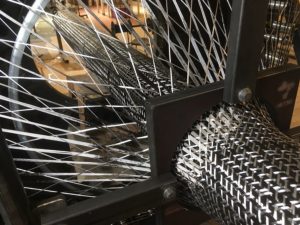CARBON FIBRE BRAIDING
One of the most important, really basic technologies used by 4tex is the method of triaxial fibre braiding. This method is a unique form of braiding individual fibres that can be formed either by carbon fibres exclusively or their combination. Unlike biaxial braiding, where two fibres under different angles are braided together, triaxial braiding adds one more fibre. This third one is intertwined with the other two in horizontal direction. This is why improved physical characteristics are achieved.
Key aspects of fibre braiding

- Fibre angle in the range of ±45˚
- Type of fibres and their combination (carbon, glass, kevlar, basalt)
- Type and quantity of fibres
All these aspects play a crucial role i the characteristics of the final product. It is only thanks to our long-standing experience that we are able to select the most appropriate composition of the braided sleeves, which guarantees the necessary physical characteristics.
It is worth mentioning that the triaxial vertical braiding machine, which facilitates the manufacture of products exceeding the length of 5 m and diameter of 40 cm, is not the only braiding machine in our company. The company also owns a biaxial horizontal braiding machine, used in less demanding cases for carbon/glass or glass/glass braiding sleeves.
Horizontal winding
In order to achieve a high quality product, it is essential to force air bubbles out of the individual layers before hardening the product. Two technologies are used for this purpose. Either the bubbles are forced out using a special separation tape, or they are sucked out with a vacuum pump. The choice of the technique depends on the type of product.
The separation tape is wound on the product using a special machine. This special “winding machine” not only winds the separation tape but primarily the carbon fibre. All depends on the concrete setting of the machine.
The technology of winding the carbon fibre on a metal mandrel is one of the most frequent technologies used in this industry. Its positive is namely low manufacture costs in case of production of big series of hollow, mostly round profiles, practically with the absence of manpower once the machine has been programmed. Its negative, though, consists in how the individual carbon fibres hold together. Unlike triaxial braiding, where the fibres are mutually interwoven, in case of horizontal winding they are only held together by the matrix (therefore delamination occurs sooner than when the fibres are braided). At the same time, when using this technology, the fibres cannot be pulled collaterally with the product, which influences its physical characteristics.
To be able to compete namely with our western neighbours, our company decided to combine the winding technology with the braiding technology. This is how both high quality and reasonable costs have been achieved.
Hardening of composites
Our company uses a great many different matrixes, namely the epoxy resin, which are hardened through heat. Therefore we own a burning chamber of the length of 5.5 m, which enables composites to be hardened at the temperature of up to approximately 175 ˚C. To obtain the highest quality, the chamber is fitted with the possibility to alter the temperature depending on the chosen programme and also to set a continual rotation of the products being hardened. Thanks to the rotation a possible delamination and curve of the product are eliminated.
